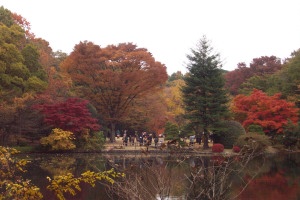



Cherishing the natural environment is a long-held Japanese tradition, and also a policy of Central Research Laboratory. When establishing the laboratory in 1942, Mr. Namihei ODAIRA, founder of Hitachi, Ltd., gave instructions to avoid cutting the trees. This policy has been adhered to by succeeding General Managers.
As a result, the Central Research Laboratory Gardens is one of the few locations in suburban Tokyo where the undisturbed natural landscape of the Musashino area can be found. Today, it is a treasured inheritance, of both employees and local residents.
There are approximately 27,000 trees and shubs located on the premises, of over 120 different species, including zelkova trees and Himalayan cedars which are several hundred years old. There are also extremely rare meta-Sequioia, which thrived during the Stone Age.
On the south side of the Central Research Laboratory Gardens, is "Ohike". Originally wetlands, the water from natural springs located on the premises were gathered to make a pond, completed in 1958. "Ohike" , itself, is one of the sources of "Nogawa" ("No" River), which gathers streams from numerous springs found in this area, and feeds "Tamagawa" ("Tama" River).
"Ohike" and the surrounding forest, provide a resting spot for over 40 species of wild birds, including mallard, Chinese bamboo partridge, starling, etc.
Kokubunji-shi, Tokyo, where Central Research Laboratory is located, is best known for the preservation of the ruins of an ancient village from the Early/Middle Jomon era (3,000-2,000 B.C.). Judging from the geography, the raised areas on which CRL stands and the springs underneath, as well as the nature of the surrounding areas, Kokubunji was an extremely suitable environment for the people of ancient times. Ruins of dwellings, earthenware pottery and other relics of from the Jomon and Yayoi Periods have been excavated, indicating that the area was a center of culture at that time.
Kokubunji was also the center of politics and education in the "Musashi" area ("Musashi-no-kuni"), now known as greater Tokyo. In the 8th century, during the Nara Period, a Buddist temple named "Musashi Kokubunji" was established in this region by the Emperor Shomu, as part of a national project to establish regional "Kokubunji"'s all over of Japan. The temple soared high above the Musashino skyline in the typical seven building layout, and was as big as the Todaiji Temple in Nara, which was the biggest temple in Japan at that time. The ruins of Musashi Kokubunji are located about one kilomether southwest of Central Research Laboratory.